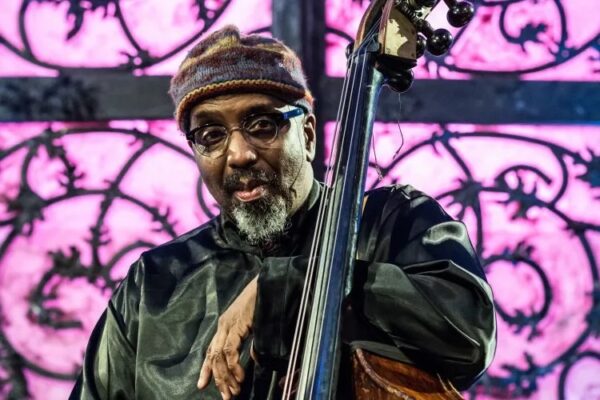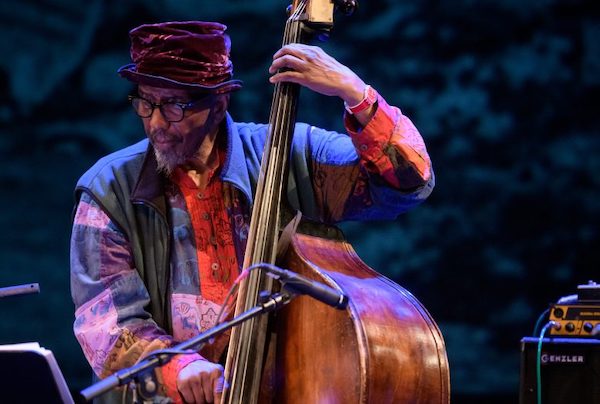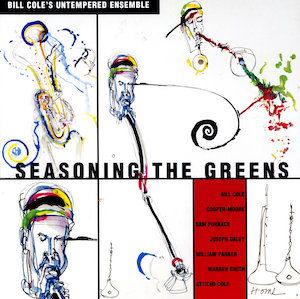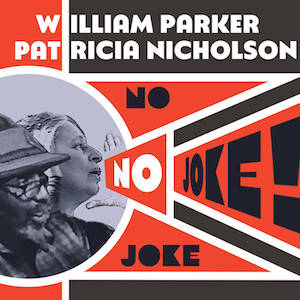Jazz Commentary: Celebrating Bassist William Parker’s Lifetime of Achievement
By Tom Hull
It was not just networking that propelled William Parker into the front rank of bassists. He could generate such a huge and complex cascade of sound that he has energized leaders from Cecil Taylor and Ivo Perelman to Zoh Amba.

Bassist William Parker. Photo: Peter Gannushkin
Back in June, 1996, the non-profit Arts for Art, led by Patricia Nicholson and her husband William Parker, organized the first Vision Festival, a celebration of art, dance, and free jazz, in New York City. The Parkers had previously organized the Sound Unity festivals in 1984 and 1988, and many other community activities. The truth is, you could fill a whole week with Parker’s friends coming over to jam with him.
Vision Fest became an annual event, and soon established itself as a renowned community forum that made new history and recognized its own. It paid homage to several recently departed musicians for its Lifetime Achievement Awards. Then, in 2006, the forum decided to honor living masters, using the occasion to organize a night’s entertainment in their honor. The first honoree was Fred Anderson, followed by Sam Rivers, Bill Dixon, Kidd Jordan, and Marshall Allen.
This year Vision Fest was fortunate to bring Allen, who’s still active leading the Sun Ra Arkestra, back to close the proceedings with a 100th birthday party bash. its also made a obvious decision: to give 72-year-old bassist William Parker its Lifetime Achievement Award, opening the festivities with a program of his work. While Parker is younger than the names I just listed, his achievements to date stand up to any of his predecessors, or to any of his contemporaries (although David Murray is rarefied company).
Parker was born in 1952 and grew up in a housing project in the Bronx. He was attracted to music from childhood, learned several instruments, but really fell in love with the double bass (or, as he’s sometimes referred to it, the “bull fiddle”), and found his life’s work. He bypassed formal training but sought out mentors, such as Jimmy Garrison, Richard Davis, and Wilbur Ware. As an adult, he moved not to Harlem, which had been the world jazz capital since Ellington arrived in the late ’20s, but to the Lower East Side, where the ’60s avant-garde had retreated to the lofts, to give birth to a new free jazz.
I think of Parker as combining two sentiments from the period: the hippie “flower power” delight in art as ecstatic experience, and the “black power” turn toward cultural enrichment as a means of propelling community. Parker eventually articulated a musical philosophy that deserves to be considered seriously. But, back in the ’70s, he pursued a form of music that few people heard patiently, and most of those who did rejected it as cacophony. I admit that I had, and sometimes still have, that reaction. For example, I was taken aback when Steven Joerg, who became Parker’s producer in the ’90s, insisted that a Kidd Jordan/William Parker album I had thought hideous was really, deeply beautiful.
In the ’70s, Parker was on the periphery of the belatedly celebrated “loft scene,” performing and sometimes recording with small groups of friends, some who went on to notable careers, like Frank Lowe, Jemeel Moondoc, David S. Ware, and the violinist who went by the name of Billy Bang. That led to a connection with Cecil Taylor, who took Walker with him to Europe, where the bassist formed lasting bonds with avant musicians like bassist Peter Kowald, drummer Tony Oxley, and rampaging sax terror Peter Brötzmann.

Bassist William Parker. Photo: Vision Fest
Parker joined Ware’s Quartet, along with Matthew Shipp and Whit Dickey, and their decade-plus run outlasted and out blasted any other quartet in jazz history (even John Coltrane’s). Shipp went on to curate the Thirsty Ear Blue Series, which heavily featured Parker and their circle, and Dickey went on to found the critically esteemed Tao Forms label. Meanwhile, what started as community organizing projects turned into ambitious vehicles for Parker’s own music: Other Dimensions in Music, a collective with Roy Campbell; In Order to Survive, first a manifesto, then ultimately the first of two great Parker quartets; and Little Huey Orchestra, the block party that developed into a full-fledged big band.
Of course, it was not just networking that propelled Parker into the front rank of bassists. He could generate such a huge and complex cascade of sound that he energized leaders as varied and imposing as Taylor, Ware, Bang, Brötzmann, Charles Gayle, Ivo Perelman, and dozens more — Ava Mendoza, Chad Fowler, and Zoh Amba are among the youngest names you should be aware of. Walker became the guy who played with everyone, and who everyone wanted to play with. When Parker started putting his name on albums, around 1994, he had already performed on 70-80 recordings. That number soon exploded: Discogs currently lists 535 albums for instruments and performance.
I’ve heard more than 250 of those records, so I thought I could flesh this out with a selected discography. Recording dates, plus release dates only if they’re 3+ years later.
William Parker: Through Acceptance of the Mystery (1974-79, Eremite ’03): Expanded reissue of the only early album released under Parker’s name (1980), sampling five different groups.
William Parker: Centering: Unreleased Early Recordings 1976-1987 (No Business ’12): A broader and deeper selection of early groups, including a big band and vocalists Ellen Christi and Lisa Sokolov, wrapped up in a nicely annotated 6-CD box. The Lithuanian label has also compiled:
- Melodic Art-Tet (1974, NoBusiness ’13): Saxophonist Charles Brackeen backed by three Sun Ra veterans plus Parker.
- Jemeel Moondoc: Muntu Recordings (1975-79, NoBusiness ’09): A 3-CD sampler from the alto saxophonist’s groups.
- Billy Bang’s Survival Ensemble: Black Man’s Blues/New York Collage (1977-78, NoBusiness ’11): Quickly established as a uniquely gifted violinist.
- Peter Kuhn: No Coming, No Going: The Music of Peter Kuhn, 1978-1979 (1978-79, NoBusiness ’16): Clarinet/saxophone player, consistently excellent until he dropped out in 1981, and again when he returned in 2015.
- Commitment: The Complete Recordings 1981/1983 (NoBusiness ’10): Quartet with Jason Kao Hwang’s razor-sharp violin, Will Connell’s reeds, and Zen Matsuura on drums.
Cecil Taylor Unit: The Eighth (1981, Hatology ’86): Parker joined Taylor’s quintet in 1980, with Jimmy Lyons (alto sax), Raphé Malik (trumpet), and Rashid Bakr (drums). Parker played with Taylor intermittently through 1990, both in the Unit and in various trios. This is a good group example.
The Feel Trio: Celebrated Blazons (1990, FMP ’93): Possibly the most dynamic of all Cecil Taylor piano trios, with Parker and Tony Oxley.
 Charles Gayle: Touchin’ on Trane (1991, FMP): Tenor saxophonist, Albert Ayler and then some, trio with Parker and Rashied Ali. Parker played on most of Gayle’s remarkable albums, but this is the one that got a Penguin Guide crown.
Charles Gayle: Touchin’ on Trane (1991, FMP): Tenor saxophonist, Albert Ayler and then some, trio with Parker and Rashied Ali. Parker played on most of Gayle’s remarkable albums, but this is the one that got a Penguin Guide crown.
Matthew Shipp Duo With William Parker: Zo (1993, Thirsty Ear ’97): Just piano and bass, but either can generate all the kinetics you could wish for.
William Parker: In Order to Survive (1993, Black Saint): This is where he finally staked his claim as a group leader.
David S. Ware: Godspelized (1996, DIW): Another Penguin Guide crown album, by Ware’s extraordinary quartet of Shipp, Parker, and Dickey, although I’m equally tempted to cite Third Ear Recitation (1992) as where they really kicked it to a higher level. One would also be remiss not to mention:
- Go See the World (1997, Columbia)
- Corridors and Parallels (2001, AUM Fidelity)
- Freedom Suite (2002, AUM Fidelity)
- Live in the World (1998-2003, Thirsty Ear): 3-CD
Sprawl (1996, Trost): An exemplary Peter Brötzmann quintet, conveys the power you expect through subtler means.
William Parker: Lifting the Sanctions (1997, No More): Solo bass, his second of several.
William Parker/In Order to Survive: The Peach Orchard (1997-98, AUM Fidelity): A major, breakthrough album, with Cooper-Moore especially brilliant on piano, as are Rob Brown (alto sax) and Susie Ibarra (drums).
William Parker/Hamid Drake: First Communion + Piercing the Veil (2000, AUM Fidelity ’07): Bass and drums duo, with extra exotica like balafon, shakuhachi, bombard, dumbek, and tabla. Reissue adds a live set.
William Parker Quartet: O’Neal’s Porch (2000, AUM Fidelity): Parker and Drake again, plus two horns — Rob Brown (alto sax) and Lewis Barnes (trumpet) — that spin off against each other spectacularly.
Roy Campbell’s Pyramid Trio: Ethnic Stew and Brew (2000, Delmark): Trumpet player, frequent Parker collaborator, especially in the group Other Dimensions in Music, but never better than here, possibly because this time Drake’s the drummer.
William Parker Clarinet Trio: Bob’s Pink Cadillac (2001, Eremite): A superb vehicle for Perry Robinson on clarinet, with Walter Perkins on drums.
William Parker Quartet Featuring Leena Conquest: Raining on the Moon (2001, Thirsty Ear): Parker’s songwriting and good intentions could pass as folk music, especially with so engaging a singer, but the band has extraordinary chops, and can flex them any time. Parker returned to this group for 2007’s Corn Meal Dance.
 Bill Cole’s Untempered Ensemble: Seasoning the Greens (2001, Boxholder): A connoisseur of exotic instruments — his lead seems to be didgeridoo — so of course he would bond with Parker and Cooper-Moore, who in turn bring in Warren Smith, Sam Furnace, Joseph Daley, etc.
Bill Cole’s Untempered Ensemble: Seasoning the Greens (2001, Boxholder): A connoisseur of exotic instruments — his lead seems to be didgeridoo — so of course he would bond with Parker and Cooper-Moore, who in turn bring in Warren Smith, Sam Furnace, Joseph Daley, etc.
William Parker Trio: . . . And William Danced (2002, Ayler): So Parker and Drake have a gig in Stockholm with Jemeel Moondoc, and they get talked into playing an early set with a local saxophonist named Anders Gahnold, and they knock this out, even better than the Jemeel Moondoc Trio’s Live at the Glenn Miller Café.
William Parker Violin Trio: Scrapbook (2002, Thirsty Ear): Parker and Drake again, this time with Billy Bang, at his best.
William Parker: Universal Tonality (2002, Centering/AUM Fidelity ’22): A 16-piece big band session plus singer Leena Conquest, better than any of the Little Huey albums.
Evan Parker Trio & Peter Brötzmann Trio: The Bishop’s Move (2003, Victo): A festival joust between the two great tenor saxophonists who founded the European avant-garde. Parker’s trio, with Alexander von Schlippenbach and Paul Lytton, goes way back, while Brötzmann tapped his “Die Like a Dog” rhythm section, William Parker and Hamid Drake. Even the bass solo breather is a highlight.
Matthew Shipp: Harmony and Abyss (2004, Thirsty Ear): After Nu Bop and Equilibrium, the high point, or perhaps the end point, of the pianist’s experiment in electronica, fed by programmer Chris Flam, with Parker on hand, as usual.
William Parker Quartet: Sound Unity (2004, AUM Fidelity): Barnes and Brown on trumpet and sax, Drake and Parker, perfectly balanced, each distinct but coherent, finding unity like a dance.
Steve Swell’s Fire Into Music: For Jemeel: Fire From the Road (2003-04, RogueArt ’23): Trombonist, leads a quartet with Jemeel Moondoc (alto sax), Parker, and Drake, on tour after their Fire Into Music album.
William Parker: Double Sunrise Over Neptune (2007, AUM Fidelity): An improbable 16-piece orchestra including string quartet, exotic instruments, two drummers, and operatic singer Sangeeta Bandyopadhyay — the sort of miracle Sun Ra used to conjure up, but two planets farther out.
 William Parker: I Plan to Stay a Believer: The Inside Songs of Curtis Mayfield (2001-08, AUM Fidelity): Long gestating album, songs that signify politics and soul, vocals by Leena Conquest and Amiri Baraka, breaking into jazz that could come from nowhere else.
William Parker: I Plan to Stay a Believer: The Inside Songs of Curtis Mayfield (2001-08, AUM Fidelity): Long gestating album, songs that signify politics and soul, vocals by Leena Conquest and Amiri Baraka, breaking into jazz that could come from nowhere else.
William Parker Orchestra: Essence of Ellington: Live in Milano (2012, AUM Fidelity): Sax-heavy big band revives some classics, including some familiar lyrics, but more often tries to distill new essences from them.
William Parker: Wood Flute Songs: Anthology/Live 2006-2012 (AUM Fidelity): An 8-CD treasure chest of live performances, the title reflecting an increasing interest in exotic instruments (wood flutes, but not just), but all of Parker’s groups get their shot.
Assif Tsahar/William Parker/Hamid Drake: In Between the Tumbling a Stillness (2015, Hopscotch): Tenor saxophonist, some terrific records from his NYC days but none better than this.
William Parker Quartets: Meditation/Resurrection (2016, AUM Fidelity): Revives his two major quartet configurations, one disc each, both with Rob Brown and Hamid Drake: Cooper-Moore is spectacular, but Lewis Barnes is missed.
Dave Sewelson: Music for a Free World (2017, FMR): Baritone saxophonist, first album as leader but he goes way back with Parker. They’re joined here by Steve Swell (trombone) and Marvin Bigalu Smith (drums). Followed by: More Music for a Free World.
Steve Swell Quintet Soul Travelers With Leena Conquest: Astonishments (2018, RogueArt): Trombonist, fabulous with Moondoc, Burrell, Parker, and Cleaver, with a poignant feature for the singer.
James Brandon Lewis Red Lily Quintet: Jesup Wagon (2020, Tao Forms): Major new tenor saxophonist, looked to history for concepts, and Ware for a model to top. Won the Francis Davis Jazz Critics Poll with this, and repeated with For Mahalia, With Love (2023). Both groups built on Parker and Chad Taylor.
William Parker: Painter’s Winter/Mayan Space Station (2020, AUM Fidelity): A pair of divergent trio releases: a look back to 2000’s Painter’s Spring (with Drake and trumpet/sax double threat Daniel Carter), and a leap into space fusion (with Cleaver and hard guitarist Ava Mendoza).
 William Parker/Patricia Nicholson: No Joke! (2019-20, ESP-Disk): Spoken word, deep and political, over brash free jazz, with saxophonists James Brandon Lewis and Devin Brahja Waldman.
William Parker/Patricia Nicholson: No Joke! (2019-20, ESP-Disk): Spoken word, deep and political, over brash free jazz, with saxophonists James Brandon Lewis and Devin Brahja Waldman.
William Parker: Migration Into and Out of the Tone World (2012-20, Centering): A 10-CD box of Parker’s wide-ranging vocal works. Not my favorite mode, but too monumental not to mention.
Andrew Cyrille/William Parker/Enrico Rava: 2 Blues for Cecil (2021, TUM): Drummer and bassist have much history with Taylor, the trumpet player also goes way back, but has a different tack.
William Parker: Heart Trio/Cereal Music (2024, AUM Fidelity): His latest release pairing: one with Cooper-Moore and Drake using exotic instruments to conjure up odd magic, the other with his words backed with Ellen Christi’s soundscapes and voice.
I should also mention that Parker has done much to document his world, interviewing his fellows for four volumes of Conversations. Two more books deserve special mention: Rick Lopez, The William Parker Sessionography appeared in print in 2014, but before and since it has stood as the definitive web resource on Parker’s career. Also see Cisco Bradley, Universal Tonality: The Life and Music of William Parker (2021).
Tom Hull studied sociology and worked in engineering, but also wrote rock criticism in the 1970s, and the Village Voice’s Jazz Consumer Guide from 2005 to 2011. He continues to blog, and has over 20,000 short reviews on his website
Tagged: AVANT JAZZ, IMPROVISATION, Jazz, LARGE ENSEMBLE, The Arts for Art
